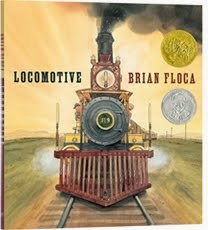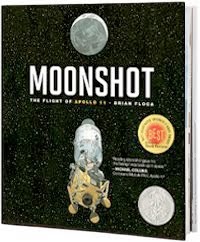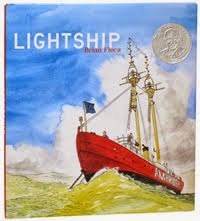Friday, July 24, 2009
Splashdown!
Forty years ago today, the Apollo 11 astronauts completed their return from the Moon, landing safely in the Pacific Ocean. Helicopters carried them from their bobbing Command Module to the USS Hornet, where they entered the Mobile Quarantine Trailer in which they would spend the next three weeks — long enough to be sure they weren’t carrying Moon germs. Above, the trip home as presented in Al Reinert’s “For All Mankind,” with music by Brian Eno.
And that's it. We’ve reached the end of what President Richard Nixon called “the greatest week in the history of the world since Creation.” If Nixon got a little carried away, let’s not blame him. It was a remarkable trip!
Thursday, July 23, 2009
Are we there yet?
“I believe that this nation should commit itself to achieving the goal, before this decade is out, of landing a man on the Moon and returning him safely to Earth,” John Kennedy said in 1961.
Forty years ago today, the landing had been accomplished, but not yet the return; the astronauts, having earlier fired their CSM engine to push themselves out of lunar orbit, were riding the long transearth coast back to home. The big event still to come: the insane (says me) plummet into the Pacific that was the reentry procedure — what that other Buzz (Lightyear) might call “falling with style.” That’s tomorrow!
Tuesday, July 21, 2009
Fit to Print

About a month before Moonshot came out this spring, I received a rather wonderful gift from one of my enablers at Atheneum/Simon & Schuster, a July 21, 1969 edition of The New York Times. (Thank you, E.D.D.) The coverage is as thorough and as interesting as you’d expect from the Times during the glory days of newsprint. The entire first section and a special supplement of the paper are devoted to Apollo; there is a wealth of informative articles about the landing itself and about how it was planned and carried out, and indeed about the whole evolution of space flight. It’s the pre-Internet Times, when the paper, in its newspaper of record role, would run pages and pages of transcripts of important events — in this case all the back and forth between Mission Control and Columbia and Eagle. There is also a description by the administrator of NASA of the moon bases, nuclear rocket shuttles, and space stations to come (by the mid ‘80s), and there are poems and commentaries on the occasion of the landing, both for and against. (Buckminster Fuller: FOR. Jesse Jackson: AGAINST.) It is, in short, a totally fascinating time capsule view of the mission and of America at the moment of it. But since there are so many sources out there, especially this week, for understanding what Apollo was and how it worked, and for ideas about what it did or didn’t mean, I thought that I’d share from the paper something a little lighter: some advertisements, which provide their own odd, narrow window into the period. I hope you’ll enjoy them, and perhaps even join me in raising a horn of mead and saying, “Thank you, Norway!”


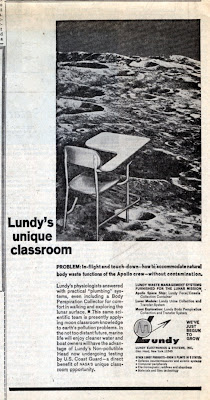


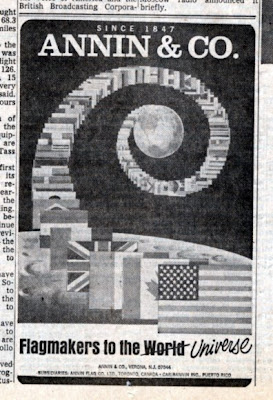

Saturday, July 18, 2009
Walter Cronkite (1916—2009)

From the New York Times obituary, here:
“As anchorman and reporter, Mr. Cronkite described wars, natural disasters, nuclear explosions, social upheavals and space flights, from Alan Shepard’s historic 15-minute ride to lunar landings. On July 20, 1969, when Neil Armstrong stepped on the moon, Mr. Cronkite exclaimed, “Oh, boy!””
At the risk of seeming as if I am (revealing that I am) seeing everything this week through the lens of Apollo, here was a man who would have enjoyed the 40th anniversary of the mission. Cronkite’s interest in the space program was not a ginned-up show-business enthusiasm, but the real thing. He had the bug. It would have felt fitting if he had made it through the week, and I’m sorry he didn’t. A bit of his CBS coverage of the landing is here:
EDITS:
1. Actually, Cronkite said “Oh, boy!” when the Eagle landed. The Brian Floca News Blog regrets the error. So does the New York Times.
2. Looks as though CBS has had this YouTube footage pulled. You can still get a little bit of Cronkite and the landing here, but CBS has packaged it to within an inch of its life and made it into something like an informercial, with guest appearances by current anchors, etc. Short of a visit to a place like the Paley Center for Media in New York or Los Angeles, I don’t know if there’s a way to get the flavor of the original footage, which seems to me a shame.
Friday, July 17, 2009
Does anyone remember where we parked?

Apparently, yes. Remarkable new photos from NASA's Lunar Reconnaissance Orbiter, here, show the Apollo landing sites. Incredible!
Radio Days
Of the links listed in yesterday’s post, the one I’ve been enjoying the most is the link to Apollo 11 Radio — the “audio time capsule” of the Apollo 11 mission that NASA is webcasting in real time this week. Listen here. I’m keeping it on in the background while working on my current looming deadline. I had no idea how much I’d enjoy it, but you can’t beat primary sources. Yes, there are long stretches of nothing but a low, humming static, but that’s all right; you could do worse than a little white noise in the background. Then, unexpectedly, the jargon comes on, most of which I can’t understand, but somehow that’s all right, too. You still get the gist. It was fascinating yesterday listening to Mike Collins and Charlie Duke try to figure out why a set of information on the ground wasn’t matching up with a set in Columbia. Sometimes the whole operation seems to have gone so smoothly that its success seems preordained, but then you listen to those guys try to get their numbers to square, while flying through space, pointed away from Earth, traveling at thousands of feet per second, and you’re reminded of what was really going on. A high tip of the hat to author, illustrator, Brooklyn neighbor, and fellow moon book maker John Rocco, who first sent me the link. Thanks, John!
Thursday, July 16, 2009
Countdown: Apollo 11

9:32 AM EDT today marks the 40th anniversary of the launch of Apollo 11.
A few of the very many ways out there to enjoy the week's commemorations of Apollo 11: You can follow along a virtual reenactment of the Apollo 11 journey — from liftoff to splashdown — at We Choose The Moon, here, from the John F. Kennedy Presidential Library & Museum. Or listen along with Apollo 11 Radio, here, a webcast from NASA that will relay in real time the audio from Apollo 11. How much of the audio? All of it! NASA describes it as an “audio “time capsule”.... Audio from the entire Apollo 11 mission will be replayed and streamed on the Internet at exactly the same time and date it was broadcast in 1969.” Bring it, NASA! That is going to be the soundtrack to my week.
For more from NASA, see their 40th anniversary Apollo site, here. A good list of other online anniversary sites has been compiled by science writer Alan Boyle, here.
Offline, if you happen to be in Washington, D.C., today remarkable astronaut/artist Alan Bean will be celebrating the opening of an exhibit of his paintings at the Smithsonian Air and Space Museum. Also there will be author Andrew Chaikin; together they will sign copies of their fantastic book for young readers, Mission Control, This is Apollo. (If you buy only two Apollo books this summer, buy Mission Control, This is Apollo.) I am proud to say that you can even catch readings (not by me) of Moonshot today at the museum, at 11:00 and 1:30. Details for all those events are here.
And, keep your eyes open for a NASA press conference this morning — more on that here — and for a better look at the Apollo 11 moonwalk than anyone has ever seen.
Now, if you follow this blog — well, first, if you follow this blog, then you’re part of a small, select group. But what I really wanted to say is, if you follow this blog, then you might know that I’ve been posting summaries of each of the manned Apollo missions on their 40th anniversary launch date. (Summaries to date are here, and they will keep coming. Watch for Apollo 12 — but not till November.) So what to say now that we’ve finally reached Apollo 11, the first manned landing on the Moon, the subject of Moonshot?
I hope it’s no slight to the other books I’ve been lucky enough to work on to say that I’ve never felt the pull of a book as deeply as I did on Moonshot. What fascinates me most and what moves me most about these voyages to the Moon, I tried to express in that book. Anything I didn’t get into Moonshot, I’m not going to find words for here. (No offense, Blogger.)
So, serve yourself up some steak and eggs (the astronauts’ breakfast before launch), crank up the audio time capsule, and Godspeed Apollo 11!
Tuesday, July 14, 2009
Today’s Moon News
Highly recommended: Today’s Science Times section of The New York Times. John Noble Wilford, A.O. Scott, and others reflect on the 40th anniversary of Apollo 11.
(A few years ago I got to see Wilford interview director (and fellow Texan) Al Reinert at a screening of Reinert’s beautiful, captivating film “For All Mankind.” If you want to spend a little time this anniversary week with images of Apollo, you won’t do better.)
Highly appreciated: Yesterday’s Fuse #8 review of Moonshot, here. For all the kindnesses within the review, I especially appreciated that Fuse tipped her hat to our taking the time to design the book’s endpapers around the fact that some libraries glue down the jacket flaps on their books. (I don’t know why they do it, but I know that they do it.) For Moonshot this meant coming up with a jacket flap-sized panel that would show readers something they might enjoy if they could see it, but that they wouldn’t miss if they couldn’t.
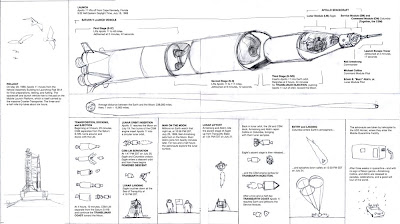
A final small note about the endpapers: In the last panel on the bottom right, you can see a figure, slightly hunched, speaking to the astronauts while they’re still in their trailer-like Mobile Quarantine Facility. It’s not the best likeness, but that figure’s identity can now be revealed.
(A few years ago I got to see Wilford interview director (and fellow Texan) Al Reinert at a screening of Reinert’s beautiful, captivating film “For All Mankind.” If you want to spend a little time this anniversary week with images of Apollo, you won’t do better.)
Highly appreciated: Yesterday’s Fuse #8 review of Moonshot, here. For all the kindnesses within the review, I especially appreciated that Fuse tipped her hat to our taking the time to design the book’s endpapers around the fact that some libraries glue down the jacket flaps on their books. (I don’t know why they do it, but I know that they do it.) For Moonshot this meant coming up with a jacket flap-sized panel that would show readers something they might enjoy if they could see it, but that they wouldn’t miss if they couldn’t.

A final small note about the endpapers: In the last panel on the bottom right, you can see a figure, slightly hunched, speaking to the astronauts while they’re still in their trailer-like Mobile Quarantine Facility. It’s not the best likeness, but that figure’s identity can now be revealed.
Wednesday, July 8, 2009
Hey, People
Tuesday, July 7, 2009
Moonshot: The Annotated Edition

I’ve just added a new page to the web site, titled Moonshot Notes. It begins like this:
I had two goals while researching and writing Moonshot: The Flight of Apollo 11.
First, I wanted to find the information that I needed to make an accurate book.
Second, I wanted to keep from beating the reader over the head with all that information. I wanted to be accurate but to evoke the mission, not exhaustively detail it.
But maybe you want some of those details. Possibly you enjoy annotated editions, director’s commentary tracks, and footnotes. Or maybe you've read Moonshot and you've asked, what’s with the yellow shoes? What are those long pointy things sticking off the legs of the Lunar Module? And who’s MOM?
If yes to any of that, then pull up a copy of Moonshot and read on.
Sunday, July 5, 2009
What would Buck Rogers Drive?

The New York Times points out that this weekend Mercedes-Benz is marking the 75th anniversary of die Silberpfeile — the racecars known as the Silver Arrows. From the Times story, here:
“As the story goes, technicians from Mercedes-Benz stripped the white paint off its grand prix cars at the 1934 International Eifel race at the Nürburgring track in Germany to bring the cars below the maximum weight permitted by the new racing formula of the time, 750 kilograms, or 1,650 pounds.
True or not, the Silver Arrows were born. Manfred von Brauchitsch delivered a win in the debut of the W 25 race car at the Nürburgring. And until 1939, when World War II put a halt to racing in Europe, the Silver Arrows were dominant on the track, matched only (and only occasionally) by race cars from its arch competitor, Auto Union.”
It was the Silver Arrows, as it happens, that brought about The Racecar Alphabet. When I came across an image of one of those cars a few years ago, a switch went off in my head. I had never been much of a racing fan, but suddenly I appreciated how extraordinarily beautiful these cars could be. Here was sculpture, nothing less. It just happened to be sculpture you could drive through scenic European settings at extraordinary speeds. The desire to spend time with those shapes and forms was the genesis of the book.
A few good pictures of Silver Arrows can be found by clicking here and scrolling down to the wallpaper images near the bottom of the page, and of course more are on the Web if you feel up to the image search.
Above: An early and unused cover painting for The Racecar Alphabet, with a Mercedes-Benz W154 in the lead and a couple of Alfa Romeos and a Bugatti playing catch up.
Thursday, July 2, 2009
Back to the bath
Bathtub V from Keith Loutit on Vimeo.
I've been remiss. There's a new Keith Loutit video that's been up for nigh on three weeks now, and I just noticed it. It may not reach the all time high that he scored with Bathtub IV, in my humble opinion, but Bathtub IV was so amazing that that's no insult. This is still pretty great.
As always with K. Loutit, remember to go for the full screen option.
Wednesday, July 1, 2009
Minimalists, shop early

The Apollo 11 anniversary month is here, and I’m happy to write that with it comes news that it’s back to the printer for more copies of Moonshot, now with a revised jacket, above. My vague sense of things is that it was the chance to include blurbs from Michael Collins and other Apollo astronauts that made reworking the design worth doing, but as long as we’re at it we’re loading the formerly restrained jacket with review quotes, too — including a review from The Bulletin of the Center for Children’s Books that’s just in, which I’m happy to write has given Moonshot its fifth starred review. Writing about both Moonshot and Robert Burleigh’s and Mike Wimmer’s One Giant Leap, BCCB says, “This pair of picture books, each featuring a poetic text that fairly begs to be read aloud, will be even better savored by independent readers who will delight in the authors’ carefully crafted storytelling while lingering over the visual renderings of the first manned moon landing.”
For those interested in additional lunar reading, BCCB has also published two lists of moon-themed books, one factual, here, and one fanciful, here.
Thanks to everyone who’s picked up a copy and sent us back for more, and to BCCB!
Subscribe to:
Posts (Atom)


